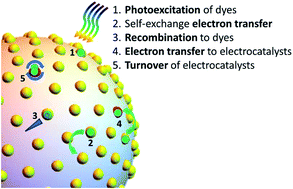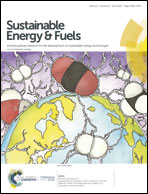Numerical Monte Carlo simulations of charge transport across the surface of dye and cocatalyst modified spherical nanoparticles under conditions of pulsed or continuous illumination†
Abstract
Solar fuel constructs consisting of discrete light-absorbers and distinct redox-active electrocatalysts are well suited for numerical modeling of their charge-transfer processes. Herein by several series of Monte Carlo simulations employing spherical nanoparticle molecular supports, we identify conditions that result in the largest yield for forming specific redox states of electrocatalysts. In general, the yield for electrocatalyst oxidation/reduction increased as the self-exchange electron-transfer time constant decreased and/or the recombination time constant increased. When the number of electrocatalysts increased to more than one per nanoparticle, yields for oxidation/reduction of electrocatalysts decreased because oxidative/reductive equivalents were diluted among the larger number of electrocatalysts. As the light intensity increased the yield for oxidation/reduction of electrocatalysts increased both in absolute number and yield per absorbed photon. However, at extreme photon fluences the yield per absorbed photon decreased due to significantly faster recombination which is clear from the equal-concentration second-order nature of the recombination reaction in the number of oxidized/reduced molecules per nanoparticle. Results obtained using electrocatalysts that only required a single oxidation/reduction event for turnover were within error the same irrespective of whether optical excitation was simulated to occur as an initial pulse, to mimic pulsed-laser spectroscopic measurements, or with repeated photoexcitation events, to mimic conditions of solar illumination. However, when electrocatalysts required multiple oxidations/reductions for turnover the intensity of pulsed light required to obtain the same electrocatalyst turnover yield that was observed using repeated photoexcitation depended greatly on the electron-transfer time constants. In addition, at solar-relevant fluences the equal-concentration second-order kinetic process for recombination exhibited a first-order dependence on the number of nanoparticles that contained an oxidized/reduced molecule. The rate of electrocatalyst turnover after two redox events was also determined to have a first-order dependence on the concentration of oxidized/reduced molecules over most of the time that oxidized/reduced molecules were present. Collectively the solar-simulated data showed that even under the assumption of ideal kinetic processes and molecular and semiconductor densities of states, the observed kinetic behavior can be complex and change as a function of time and fluence. These observations suggest that results from pulsed-laser spectroscopic measurements are not always accurate predictors of the expected behavior of sunlight-illuminated dye-sensitized photoelectrochemical cells that drive multiple-charge-transfer reactions.



 Please wait while we load your content...
Please wait while we load your content...